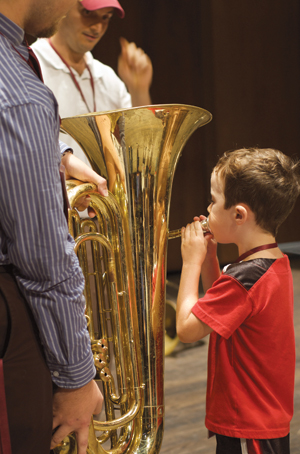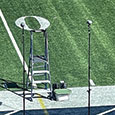 Sometimes you have to think like a child in order to reach one. Teachers who understand the mindsets of students can develop better teaching strategies. Here are some helpful ideas to encourage success in instrumental music.
Sometimes you have to think like a child in order to reach one. Teachers who understand the mindsets of students can develop better teaching strategies. Here are some helpful ideas to encourage success in instrumental music.
1. Instrumental music is an elective; students don’t have to be there.
You can quit band and orchestra, but you can’t quit math. It can be difficult to walk the line between music education and music edu-tainment. Strive to straddle the line as best you are able.
It absolutely has to be fun for students, because there are many other fun things they can do outside of school. Be witty. Tell a joke. Sing in opera style. Imitate the principal (one of our favorites). Speak in a bad accent. Act like a cartoon character. Pretend to be a villain. While doing all of this, trick them into learning.
Here’s an example. With improvised melody sung in falsetto operatic soprano style, “In Italian, in Italian, in Italian, mezzo means middle. So mezzo, so mezzo, so mezzo means ____.” (Use body motions to encourage students to fill in the blank). Proceed with this technique to teach mezzo forte and mezzo piano. That is much more interesting and memorable for young students than simply stating, mezzoforte means medium strong.
2. Few students learn music the same way you do.
For music teachers music likely has always been easier for you than for the general population. John Gardner, who wrote Frames of Mind: The Theory of Multiple Intelligences, might suggest that musicians and music teachers have heightened musical intelligence. Some students in music classes may also, but many do not. Keep this in mind when students play F natural instead of F sharp for the seventh consecutive time. They just may not see, hear, or understand that they are playing an incorrect pitch. It could be poor focus, but some students may be trying so hard but lack a fundamental understanding of what keys to press, why the F is sharp and not natural, and so on. Be patient, because at some point along your path, a music teacher was probably very patient with you.
3. Children are smart and able to absorb lots of information
Children are, as the saying goes, like sponges. It is easier for most people to learn a world language as children than as an adult, and music is in many ways another language. Often students don’t realize just how much they can learn. We like to share as much information as possible in a thirty minute lesson. It is unreasonable to expect students to remember every concept from every lesson, but they learn more than they realize. It is important and encouraging to remind them of their progress.
4. Accommodate student needs and attention spans.
Recently we were discussing teaching strategies with a non-music teacher in a neighboring school district. This teacher described how students have changed in recent years. Several years ago 3% of this neighboring school district’s incoming kindergarten students required Individualized Education Plans (I.E.P.s) That number this year is 22%. What a staggering increase.
Many of the students today are different, more needy, and less prepared, than those of only a few years ago. If a student has difficulty reading his ABCs, how likely is it that he will be able to decode musical indications on a staff-lined paper? It is perfectly acceptable to be creative in marking notes and symbols for students who need them. Another option is to chunk information into smaller bite-sized pieces or take breaks to stand up and stretch to help students with short attention spans. The alternative is that students become frustrated and quit.
5. Guilt is often more effective than criticism.
Think about that grandmotherly teacher on your faculty who can coerce you into volunteering to man the Saturday bake sale table, or the minister who, before you know it, has somehow convinced you to take an elderly shut-in to a doctor’s appointment. Used properly, guilt can be a spectacular motivator.
Which teacher would you be more likely to respond to?
Teacher A, huffily barking, “For the eighth time, trumpet players, F sharp is second valve!”
Teacher B, slumped body posture, sleepy dog eyes, hushed tone: “Trumpet players, I’m so sad that you can’t seem to remember that F sharp is second valve. I thought for sure you were better than that.”
6. Imagine each student as the superintendent or school board president twenty years from now. Even better: imagine each student as your child.
We are professionals. Sometimes, though, there are just those few students we can’t seem to reach. It would be very easy to give up on them, to let them just quit without much of an argument. If you knew, however, that the student holding that violin, sounding unearthly, were to someday be your boss or was your own child, you would want that student to succeed and would do everything in your power to help him.
It sounds cliche, but think back to the overly dramatic scene near the end of Mr. Holland’s Opus when a former clarinet student reappears years later. We should all try to be a bit like Mr. Holland. No, “play the sunset” will not usually suffice, but putting forth the effort to create the extra scale exercises, find the right recordings, or adapting the music so that it is playable is what we would want our own childrens’ teachers to do.
7. Many young students are pleasers.
So many subjects in school require the right answer. Fortunately in music, we don’t have to have every right answer until the performance. Try to create a classroom environment that encourages students to feel comfortable with making mistakes. There is one student we share, an outstanding violinist and clarinetist, who comes to class each week with exciting news about how much she practiced. She often travels with her instruments on visits to see grandparents so she can play concerts for them. The most important part of her excitement is that she always has an intelligent question to ask that really shows that she is interested in the music we give her. A comment to the effect of “Wow, what a great question!” goes a long way to encourage more in the future.
8. Students want things to be easy
While waiting for young musicians to mature and realize that hard work is important, disguise the challenges. Most string students do not learn F natural in their first year. We teach it by Thanksgiving that year, using a song they know well, “Hot Cross Buns.” We discuss major and minor modalities and then tell them that to play “Cold Cross Buns,” they will use an F natural. By tone and words, we make major and minor sound like the easiest, most normal thing on the planet. Search for new ways to teach difficult techniques and concepts. That being said, young instrumentalists do need to learn that if they want to excel at their instrument, there is no substitute for many hours of practice.
9. Some students are not intrinsically motivated.
Some students need that sticker, prize, incentive, or extra reward to keep going. For first-year instrumentalists, we have a Practicing Hall of Fame. Before the first lesson, we post a list of everyone’s names, with twenty columns to the right of them. At each lesson, students can add stickers next to their names if they have practiced on four different days and bring in a practice sheet signed by a parent. We give small prizes for the first sticker. Prizes are given at increments of five stickers, and get more interesting as students progress. Lunch with the teacher (and a friend) is always a big hit. Quite often, students will bring friends who don’t play in our ensembles, so we have increased opportunities for recruiting.
10. It’s fun to work together.
Students will play with almost anyone at recess, or at the very least, can easily be encouraged to include others. In band and orchestra classes, students enjoy teaching other students. This gives them a sense of pride and accomplishment that is irreplaceable, and it reinforces what they already know. When one student returns from being absent at the previous lesson, another student is put in charge of catching them up. This can be a highly effective motivator at any grade level. The student who has just returned from missing school is equally attentive when learning from another student as from a teacher. We always guide the teaching students to make sure they include all important material. Working together toward a common goal is also at the foundation of musical performance.
Teaching beginning instrumentalists is challenging, but fulfilling. Thinking like a young student has been useful in creating success with these aspiring musicians. Whether you are in your first year of teaching or have been teaching since the dinosaurs, it can be valuable to step back and assess how well your methods reach the young dynamos of energy that fill your classrooms. Be sure to mimic that energy and mirror that enthusiasm, and chances are your students will continue to excel.





